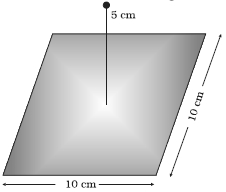A point charge $+10\; \mu \,C$ is a distance $5 cm$ directly above the centre of a square of side $10 \;cm ,$ as shown in Figure. What is the magnitude of the electric flux through the square?

A point charge $+10\; \mu \,C$ is a distance $5 cm$ directly above the centre of a square of side $10 \;cm ,$ as shown in Figure. What is the magnitude of the electric flux through the square?

The square can be considered as one face of a cube of edge $10 \,cm$ with a centre where charge $q$ is placed. According to Gauss's theorem for a cube, total electric flux is through all its six faces.
$\phi_{\text {Total}}=\frac{q}{\varepsilon_{0}}$
Hence, electric flux through one face of the cube i.e., through the square is
$\phi=\frac{\phi_{\text {Total}}}{6}=\frac{1}{6} \cdot \frac{q}{\varepsilon_{0}}$
Where, $\varepsilon_{0}=$ Permittivity of free space $=8.854 \times 10^{-12}\, N ^{-1} \,C ^{2} \,m ^{-2}$
$q=10\, \mu \,C=10 \times 10^{-6} \,C$
$=1.88 \times 10^{5} \,N \,m ^{2} \,C ^{-1}$
$\therefore \phi=\frac{1}{6} \cdot \frac{10 \times 10^{-6}}{8.854 \times 10^{-12}}$
Therefore, electric flux through the square is $1.88 \times 10^{5} \;N \;m ^{2} \,C ^{-1}$
Similar Questions
Is electric flux scalar or vector ?
Is electric flux scalar or vector ?
The wrong statement about electric lines of force is
The wrong statement about electric lines of force is
Three positive charges of equal value $q$ are placed at vertices of an equilateral triangle. The resulting lines of force should be sketched as in
Three positive charges of equal value $q$ are placed at vertices of an equilateral triangle. The resulting lines of force should be sketched as in
- [AIEEE 2012]
Why do electric field lines not form closed loop ?
Why do electric field lines not form closed loop ?
If the electric flux entering and leaving an enclosed surface respectively is ${\varphi _1}$ and ${\varphi _2}$ the electric charge inside the surface will be
If the electric flux entering and leaving an enclosed surface respectively is ${\varphi _1}$ and ${\varphi _2}$ the electric charge inside the surface will be
- [AIEEE 2003]


